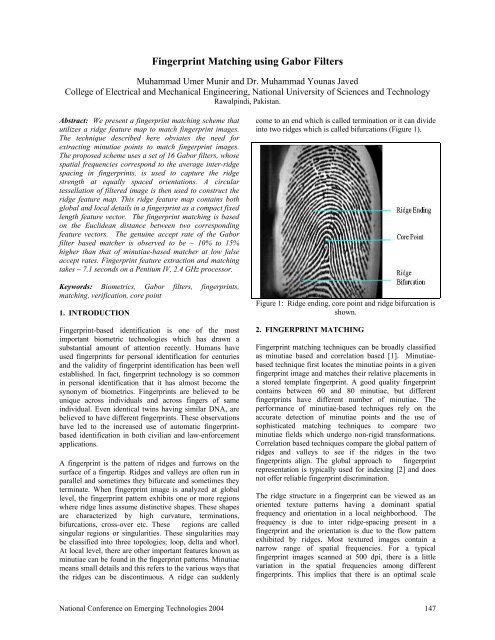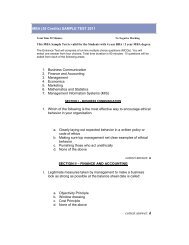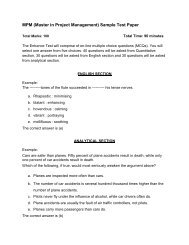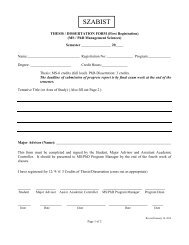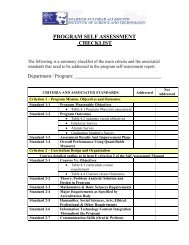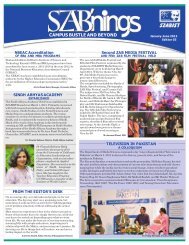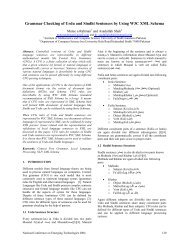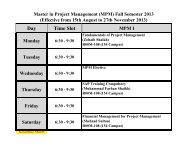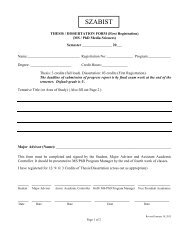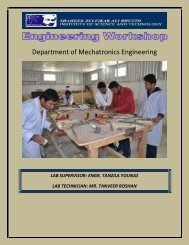Fingerprint Matching using Gabor Filters - SZABIST
Fingerprint Matching using Gabor Filters - SZABIST
Fingerprint Matching using Gabor Filters - SZABIST
Create successful ePaper yourself
Turn your PDF publications into a flip-book with our unique Google optimized e-Paper software.
<strong>Fingerprint</strong> <strong>Matching</strong> <strong>using</strong> <strong>Gabor</strong> <strong>Filters</strong>Muhammad Umer Munir and Dr. Muhammad Younas JavedCollege of Electrical and Mechanical Engineering, National University of Sciences and TechnologyRawalpindi, Pakistan.Abstract: We present a fingerprint matching scheme thatutilizes a ridge feature map to match fingerprint images.The technique described here obviates the need forextracting minutiae points to match fingerprint images.The proposed scheme uses a set of 16 <strong>Gabor</strong> filters, whosespatial frequencies correspond to the average inter-ridgespacing in fingerprints, is used to capture the ridgestrength at equally spaced orientations. A circulartessellation of filtered image is then used to construct theridge feature map. This ridge feature map contains bothglobal and local details in a fingerprint as a compact fixedlength feature vector. The fingerprint matching is basedon the Euclidean distance between two correspondingfeature vectors. The genuine accept rate of the <strong>Gabor</strong>filter based matcher is observed to be ~ 10% to 15%higher than that of minutiae-based matcher at low falseaccept rates. <strong>Fingerprint</strong> feature extraction and matchingtakes ~ 7.1 seconds on a Pentium IV, 2.4 GHz processor.Keywords: Biometrics, <strong>Gabor</strong> filters, fingerprints,matching, verification, core point1. INTRODUCTION<strong>Fingerprint</strong>-based identification is one of the mostimportant biometric technologies which has drawn asubstantial amount of attention recently. Humans haveused fingerprints for personal identification for centuriesand the validity of fingerprint identification has been wellestablished. In fact, fingerprint technology is so commonin personal identification that it has almost become thesynonym of biometrics. <strong>Fingerprint</strong>s are believed to beunique across individuals and across fingers of sameindividual. Even identical twins having similar DNA, arebelieved to have different fingerprints. These observationshave led to the increased use of automatic fingerprintbasedidentification in both civilian and law-enforcementapplications.A fingerprint is the pattern of ridges and furrows on thesurface of a fingertip. Ridges and valleys are often run inparallel and sometimes they bifurcate and sometimes theyterminate. When fingerprint image is analyzed at globallevel, the fingerprint pattern exhibits one or more regionswhere ridge lines assume distinctive shapes. These shapesare characterized by high curvature, terminations,bifurcations, cross-over etc. These regions are calledsingular regions or singularities. These singularities maybe classified into three topologies; loop, delta and whorl.At local level, there are other important features known asminutiae can be found in the fingerprint patterns. Minutiaemeans small details and this refers to the various ways thatthe ridges can be discontinuous. A ridge can suddenlycome to an end which is called termination or it can divideinto two ridges which is called bifurcations (Figure 1).Figure 1: Ridge ending, core point and ridge bifurcation isshown.2. FINGERPRINT MATCHING<strong>Fingerprint</strong> matching techniques can be broadly classifiedas minutiae based and correlation based [1]. Minutiaebasedtechnique first locates the minutiae points in a givenfingerprint image and matches their relative placements ina stored template fingerprint. A good quality fingerprintcontains between 60 and 80 minutiae, but differentfingerprints have different number of minutiae. Theperformance of minutiae-based techniques rely on theaccurate detection of minutiae points and the use ofsophisticated matching techniques to compare twominutiae fields which undergo non-rigid transformations.Correlation based techniques compare the global pattern ofridges and valleys to see if the ridges in the twofingerprints align. The global approach to fingerprintrepresentation is typically used for indexing [2] and doesnot offer reliable fingerprint discrimination.The ridge structure in a fingerprint can be viewed as anoriented texture patterns having a dominant spatialfrequency and orientation in a local neighborhood. Thefrequency is due to inter ridge-spacing present in afingerprint and the orientation is due to the flow patternexhibited by ridges. Most textured images contain anarrow range of spatial frequencies. For a typicalfingerprint images scanned at 500 dpi, there is a littlevariation in the spatial frequencies among differentfingerprints. This implies that there is an optimal scaleNational Conference on Emerging Technologies 2004 147
6.7 seconds, is taken by the convolution of the input imagewith 16 <strong>Gabor</strong> filters. The convolution operation can bemade significantly faster by dedicated DSP processors. Ifthe core point is correctly located, the features aretranslation invariant and the rotation handled in thematching stage is very fast. As a result, the matchingprocess is extremely fast.9. SUMMARY AND FUTURE WORKWe have presented a fingerprint matching scheme thatutilizes both the frequency and orientation informationavailable in a fingerprint. Sixteen <strong>Gabor</strong> filters are used toextract features from the template and input images. Theprimary advantage of our approach is improved translationand rotation invariance. The following areas ofimprovement are also being studied:(1) New matching methods for comparing the ridgefeature maps of two images(2) Constructing the ridge feature maps <strong>using</strong> adaptivemethods for optimal selection of <strong>Gabor</strong> filtersREFERENCES[1] D. Maltoni, D. Maio, A. K. Jain, and S. Prabhakar,Handbook of <strong>Fingerprint</strong> Recognition, Springer-Verlag, June 2003.[2] A. K. Jain, S. Prabhakar and L. Hong, "AMultichannel Approach to <strong>Fingerprint</strong>Classification", IEEE Transactions on PAMI,Vol.21, No.4, pp. 348-359, April 1999.[3] A. Ross, A. K. Jain, and J. Reisman, "A Hybrid<strong>Fingerprint</strong> Matcher", Pattern Recognition, Vol.36, No. 7, pp. 1661-1673, 2003.[4] A. K. Jain, A. Ross, and S. Prabhakar, "<strong>Fingerprint</strong><strong>Matching</strong> Using Minutiae and Texture Features",Proc International Conference on ImageProcessing (ICIP), pp. 282-285, Greece, October7-10, 2001.[5] L. Hong, Y. Wan and A.K. Jain, "<strong>Fingerprint</strong>Image Enhancement: Algorithms and PerformanceEvaluation", IEEE Transactions on PAMI, Vol. 20,No. 8, pp.777-789, August 1998.[6] A. R. Rao, A Taxonomy for Texture Descriptionand Identification, New York: Springer-Verlag,1990.[7] J. Daugman, Recognizing persons by their irispatterns, in: A. K. Jain, R. Bolle, S. Pankanti(Eds.), Biometrics: Personal Identification in aNetworked Society, Kluwer Academic Publishers,1999, pp. 103-121.[8] Anil K. Jain, Lin Hong, Sharat Pankanti, and RuudBolle, “An identity authentication system <strong>using</strong>fingerprints,” Proceedings of the IEEE, vol. 85,no. 9, pp. 1365–1388, 1997National Conference on Emerging Technologies 2004 151


